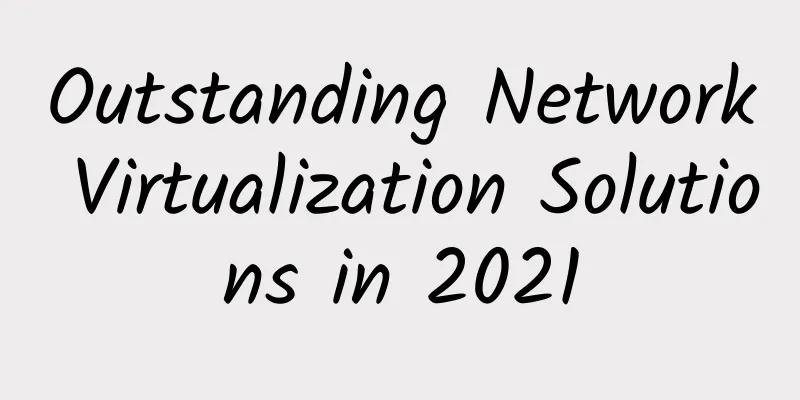Outstanding Network Virtualization Solutions in 2021

|
Hardware maintenance has always been a major problem that enterprises have had to face. Regular upgrade and maintenance plans, high-cost repairs and replacements, the complexity and high cost of hardware management have prompted many companies to adopt virtualization, or convert computer storage, servers and other network hardware into virtual versions for easier maintenance and deployment on the network. Network virtualization converts physical network hardware into software, thereby increasing network flexibility and scalability.
What is Network Virtualization?Network virtualization focuses on creating a software-based view and management of the network, transforming traditional network hardware into a more flexible and portable software version. The process of creating a virtual network involves separating the management plane of the network from the control plane and combining existing network hardware and software components into a unified software entity. Virtual networks typically retain their hardware to implement problems such as packet forwarding, but all other network functions are performed on the virtual network, completely separated from the previous hardware. Depending on the goals of an enterprise network and the existing hardware and software, they can choose between three types of network virtualization:
Excellent Network Virtualization Market SolutionEnterprise Networking Planet, a US technology media, evaluated various network virtualization solutions. The following ranking is in no particular order. VMware NSXVMware NSX is considered the industry standard for network virtualization and security, with a focus on bringing networking and security closer to the application and the virtual machines that run it. Many users choose VMware NSX to achieve use cases and enterprise goals such as zero-trust security, multi-cloud networking, network automation, container networking, SDN automation, rapid workload migration and load balancing. In addition to traditional virtual machines, NSX also provides top-notch security and monitoring capabilities for containerized applications and microservices. feature:
Pros: Virtualization security features are very strong and numerous, covering end-to-end encryption, micro-segmentation, and end-to-end visibility. Disadvantages: There are issues with interoperability with external vendors and their products. Cisco Enterprise Network Functions VirtualizationCisco Enterprise Network Function Virtualization is a Cisco-supported solution for virtual network deployment and ongoing management. Like many other network virtualization solutions, its goal is to simplify localized enterprise operations by reducing hosted hardware and moving network functions to software on x86-based platforms. The product helps enterprise network administrators monitor all network issues while also providing additional resources to orchestrate and manage services, thereby improving incident response speed. feature:
Pros: Cisco has a strong background in network security and can offer several advanced security features to its NFV customers. Disadvantages: Some users expressed interest in a modular upgrade product. FlexiHubFlexiHub is used more as a third-party support resource, or even as an alternative for businesses that require a lot of mobile hardware maintenance and want to outsource these operations. The solution is particularly powerful for businesses in the service industry, as FlexiHub's core goal involves creating virtual network connections or providing support for customers remote sensor, vehicle or smartphone diagnostics. At the same time, remote maintenance, monitoring and troubleshooting can also be applied to corporate equipment and other hardware. feature:
Pros: Covers IoT devices and data management, and is an advanced third-party service for traditional and mobile enterprise devices. Cons: Flexihub sometimes fails to recognize the remote device it is trying to connect to. SolarWinds Virtualization ManagerSolarWinds Virtualization Manager does not assist with migration or initial startup of network tools in virtual environments, but the tool does provide strong support in areas such as hypervisor management, virtual machine monitoring, and troubleshooting. Because the software is focused on virtual network performance management, Virtualization Manager is particularly good at providing single-panel data visualization and other analytical customizations, allowing system administrators to better understand the solutions they need. SolarWinds Virtualization Manager is often integrated with the SolarWinds Orion Platform, which is a big advantage for users who also need additional storage resource monitoring (SRM), virtualization management (VMAN), and network performance monitoring (NPM). feature:
Pros: This SolarWinds product can troubleshoot various enterprise virtualization setups (servers, storage and virtual networks) from a single management pane. Cons: Many users find the SolarWinds licensing process complex and expensive. oVirtoVirt is a free, open source virtualization solution that runs on the KVM hypervisor and is built on community projects such as libvirt, Gluster, PatternFly, and Ansible. The solution is a powerful virtualization management platform for developers who want to customize the source code and collaborate with other developer communities for troubleshooting and optimization. Much like other open source platforms, oVirt provides extensive documentation, communities, forums, and blogs to guide enterprise developers in implementing the oVirt solution. feature:
Pros: The product is easy to use and manage, especially for virtualized storage management. Disadvantages: Although the tool is compatible with products from other vendors, most vendors don't recognize or know how to integrate oVirt solutions. VagrantVagrant is an open source software developed by HashiCorp. It is specifically used to develop and manage portable virtual software development environments. The main purpose of this product is to simplify software configuration management to improve the efficiency of virtual networks. VirtualBox, KVM, Hyper-V, Docker, VMware, AWS and other mainstream platforms are compatible with the Vagrant development environment. feature:
Pros: Vagrant provides detailed documentation to explain its features and guide developers and non-developers alike through the deployment process. Disadvantages: The command line and other initial deployment features in Vagrant are more complicated than similar features in Linux and other tools. Altaro Virtual Machine BackupAltaro VM Backup is a popular backup and replication solution designed specifically for virtual machines. Its most powerful feature is data deduplication through enhanced inline deduplication. Altaro VM Backup improves backup efficiency and reduces the required storage space by running deduplication on all backup jobs. The storage space required for virtual networks is significantly reduced, saving enterprises a lot of costs. feature:
Pros: The variety of virtual machine backup options is a great resource for disaster recovery needs. Cons: File sharing and file-specific backups are a problem for some users. GigaVUE-VMIn the process of network virtualization, many network administrators are concerned that they will lose the operational visibility they previously had on traditional hardware and software. GigaVUE-VM is Gigamon's primary solution to this problem, providing additional network monitoring and traffic forwarding to external security and monitoring solutions used by the company. Users can both monitor their virtual environment through the GigaVUE-VM interface and continue to use their previous security and monitoring solutions through the forwarding capabilities. GigaVUE-VM is also tightly integrated with VMware NSX and ESX, making it an ideal network visibility solution for VMware users. feature:
Pros: Gigamon functionality is easy to deploy. Cons: The tool is considered somewhat expensive, especially when compared to open source security alternatives. Original link: https://www.enterprisenetworkingplanet.com/guides/network-virtualization-software/ |
<<: In order to "force" users to switch to 5G, operators have come up with new moves?
>>: Why does TCP need a three-way handshake? Explain it to you in the most popular words
Recommend
RepriseHosting: $28.54/month-L5640/16G memory/240G SSD+8TB HDD/1Gbps bandwidth/Seattle data center
RepriseHosting recently launched a limited-editio...
Watch Process Little P tell its network performance story!
[[394922]] This article is reprinted from the WeC...
XSX: Japan/Singapore dedicated servers 50% off, E3-1230v3/16GB/480G SSD only $57
XSX.net recently launched a 50% discount promotio...
5G: A new vision for industrial automation
The next generation of wireless connectivity, 5G,...
Reject poor digital experience! Riverbed creates agile and visual management solutions
According to an IDC report, by 2018, 67% of the w...
One year later, let’s talk about Open RAN again
[[385310]] This article is reprinted from the WeC...
One person, one device, one password: Ruijie Flexible Office provides Lujia Paint with a "Wi-Fi Security Key"
Since the advent of Wi-Fi, users have had to face...
50% off spinservers: San Jose data center starting at $19/month, dual core, 8G memory, 200G SSD, 10TB monthly traffic
In addition to dedicated servers, spinservers'...
Why Microsoft's acquisition of Nuance is a big deal
[[394293]] Microsoft recently announced that it w...
400G technology development will become clearer in 2017
With the rapid development of technologies such a...
Aruba Again Named a Leader in Gartner Magic Quadrant for WAN Edge Infrastructure
September 22, 2021 – Aruba, a Hewlett Packard Ent...
After 5G entered the market, the driving effect began to emerge
On September 21, the three major operators releas...
IPv6 is coming, what should we do with SDN?
IPv6 has been called for so many years, and final...
I strongly oppose passing data between services through cache!
[[408610]] The movement of data requires a carrie...
Understanding CPU, GPU, ASIC and FPGA in one article
With the rapid development of science and technol...









